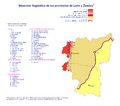Leonese language facts for kids
Quick facts for kids Leonese |
||||
|---|---|---|---|---|
| Native to | Spain, Portugal | |||
| Region | Provinces of León (north and west), Zamora (north-west) in Spain, and the towns of Rionor and Guadramil in northeastern Portugal; Mirandese dialect in Portugal. | |||
| Native speakers | 20,000–50,000 (2008) | |||
| Language family |
Indo-European
|
|||
| Official status | ||||
| Official language in | As of 2010, has special status in the Spanish autonomous community of Castile and León | |||
| Linguasphere | 51-AAA-cc | |||
|
||||
The Leonese language (called Llionés in Leonese) is a special language spoken in parts of Spain and Portugal. It is a Romance language, which means it comes from Latin, just like Spanish, Portuguese, and French. Long ago, in the Middle Ages, Leonese was the main language of the Kingdom of León.
Today, the United Nations (UN) says Leonese is "seriously endangered." This means it is at risk of disappearing. However, the region of Castile and León in Spain officially recognizes the language.
Contents
Learning Leonese: Where is it Taught?
Leonese is taught in some schools in the city of León. There are sixteen schools where kids can learn it. Adults can also take lessons in many villages in the León and Zamora areas.
For about fifteen years, some groups have offered Leonese classes. Sometimes, local governments helped them. But it has been hard to keep these classes going. Often, the teachers were not specially trained. Also, the classes were sometimes far from where Leonese is actually spoken.
What Makes Leonese Endangered?
UNESCO, a part of the UN, lists Leonese as a language in danger. It faces many challenges that put it at risk.
Here are some reasons why Leonese is endangered:
- It is not an official language. This means it doesn't have special legal protection.
- You won't hear it much in the news or on TV.
- Not many people know or use the language regularly.
- Some people don't see it as important.
- It is not usually taught in schools as a main subject.
- Place names (like towns or rivers) are not always written in Leonese.
How Leonese Compares to Other Languages
Leonese is a Romance language. This means it shares many similarities with other languages that came from Latin. Look at how some words are similar across different languages:
| Leonese | Portuguese | French | Italian | Venetian | Spanish | Latin | English |
|---|---|---|---|---|---|---|---|
| facere | fazer | faire | fare | fare | hacer | facere | make |
| fiyu | filho | fils | figlio | fiolo | hijo | filius | son |
| fame | fome | faim | fame | fame | hambre | fames | hunger |
| gochu | porco | cochon | maiale | porselo | cerdo | sus | pig |
| vieyu | velho | vieux | vecchio | vecio | viejo | vetus | old |
| chovere | chover | pleuvoir | piovere | piòvare | llover | pluere | rain |
Learning Leonese Words
Here are some common words in English and how they sound in Leonese. Can you try to say them?
| English | Leonese |
|---|---|
| Numbers | Númberos |
| one | unu |
| two | dous (m), duas (f) |
| three | tres |
| four | cuatru |
| five | cincu |
| six | seis |
| seven | siete |
| eight | ochu |
| nine | nueve |
| ten | diez |
Leonese Literature: Stories and Books
People have been writing in Leonese since the Middle Ages. The very first known text in Leonese is called the Nodicia of Kesos. It was found in Ardón and dates back to 959 or 974 AD.
Other important old writings in Leonese include:
- Fueru de Llión
- Fueru de Salamanca
- Fueru Xulgu
- Códice d'Alfonsu XI
- Disputa d'Elena y María
- Llibru d'Alixandre
Famous writers from the past who used Leonese include Torres Naharro, Juan del Encina, and Lucas Fernández. In the early 1900s, writers like Caitano Bardón (who wrote Cuentos en Dialecto Leonés), Luis Maldonado, and Aragón Escacena (who wrote Entre brumas) helped bring Leonese literature back to life.
Today, there are still important writers using Leonese. Some well-known names from the late 20th century include Eva González. More recent writers include Abel Pardo, Xuasús González, Adrianu Martín, and Félix Llópez.
Images for kids
See also
 In Spanish: Leonés (asturleonés de León y Zamora) para niños
In Spanish: Leonés (asturleonés de León y Zamora) para niños








